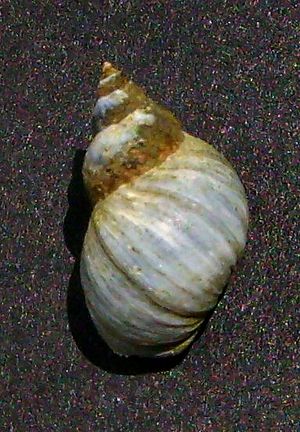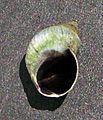Blue banded periwinkle facts for kids
Quick facts for kids Blue Ball banded periwinkle |
|
|---|---|
 |
|
| Scientific classification | |
| Kingdom: | |
| Phylum: | |
| Class: | |
| (unranked): |
clade Caenogastropoda
clade Hypsogastropoda clade Littorinimorpha |
| Superfamily: |
Littorinoidea
|
| Family: |
Littorinidae
|
| Subfamily: |
Littorininae
|
| Genus: |
Austrolittorina
|
| Species: |
A. antipodum
|
| Binomial name | |
| Austrolittorina antipodum Philippi, 1847
|
|
| Synonyms | |
|
|
The banded periwinkle, known scientifically as Austrolittorina antipodum, is a small sea snail. It's a type of marine gastropod, which means it's a snail that lives in the ocean. This little creature belongs to the winkles and periwinkles family, called Littorinidae. You can find the banded periwinkle living along the coasts of New Zealand.
Contents
About the Banded Periwinkle
The banded periwinkle is a species of snail that lives in the sea. It's quite small, usually only a few centimeters long. Like other snails, it has a hard shell that protects its soft body. The shell often has bands or patterns, which gives this snail its common name, "banded periwinkle."
What is a Gastropod?
A gastropod is a type of mollusc. Snails and slugs are common examples of gastropods. The word "gastropod" means "stomach-foot." This is because their body and foot are connected in a way that looks like their stomach is on their foot. They use their strong, muscular foot to move around.
Where it Lives
The banded periwinkle lives in the intertidal zone of New Zealand. This is the area along the coast that is covered by water during high tide and exposed to the air during low tide. These snails are very good at surviving in this tough environment. They can handle being out of the water for hours.
Surviving the Tides
When the tide goes out, the banded periwinkle often attaches itself firmly to rocks. It can seal its shell opening with a special lid called an operculum. This helps it keep moisture inside and protects it from drying out. It also protects the snail from predators like birds.
What Periwinkles Eat
Most periwinkles, including the banded periwinkle, are herbivores. This means they eat plants. They mostly feed on tiny algae and other plant material that grows on rocks. They use a special tongue-like organ called a radula to scrape food off surfaces.
Role in the Ecosystem
Even though they are small, periwinkles play an important role in their ecosystem. By eating algae, they help keep the rocks clean. They also become food for other animals, like crabs and birds. This makes them a part of the ocean's food chain.
Discovery and Classification
The scientific name for the banded periwinkle is Austrolittorina antipodum. It was first described by a scientist named Rodolfo Amando Philippi in 1847. Giving animals scientific names helps scientists around the world know exactly which creature they are talking about.
Family Tree
The banded periwinkle belongs to the family Littorinidae. This family includes many different types of periwinkles and winkles. They are all sea snails that live in coastal areas. Scientists group animals into families based on their shared features and evolutionary history.
Related Species
There are many other species of periwinkles found around the world. While they might look similar, each species has its own unique features and preferred habitat. Studying these differences helps scientists understand how life on Earth has changed over time.
Images for kids


